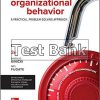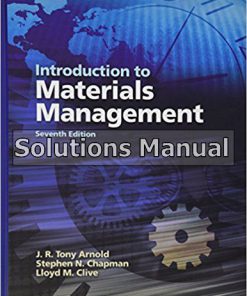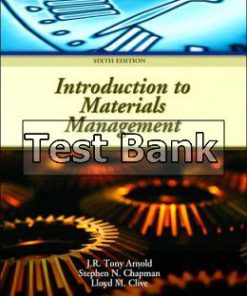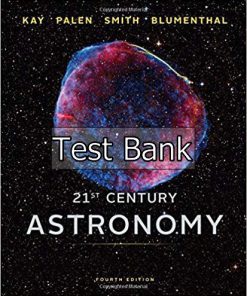Introduction to Materials Management 8th Edition Chapman Test Bank
$50.00 Original price was: $50.00.$26.50Current price is: $26.50.
Introduction to Materials Management 8th Edition Chapman Test Bank.
This is completed downloadable of Introduction to Materials Management 8th Edition Chapman Test Bank
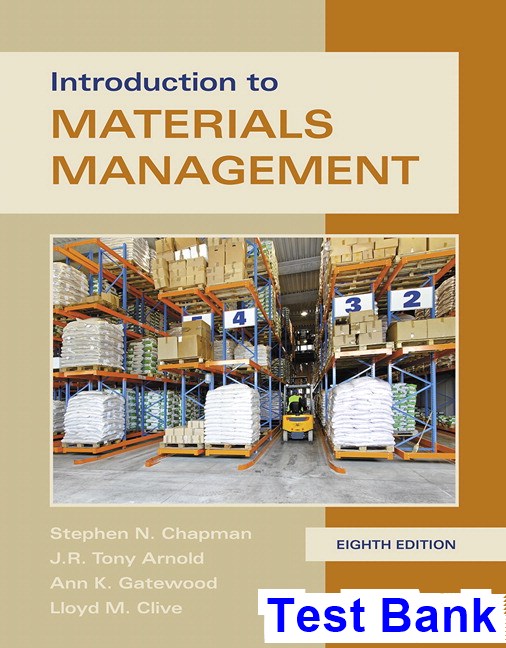
Product Details:
- ISBN-10 : 0134156323
- ISBN-13 : 978-0134156323
- Author: Stephen N. Chapman, Ann K. Gatewood
Introduction to Materials Managementcovers all the essentials of modern supply chain management, manufacturing planning and control systems, purchasing, and physical distribution. Clearly written and exceptionally user-friendly, it’s content, examples, questions, and problems lead students step-by-step to mastery. Widely adopted by colleges and universities worldwide, this is the only APICS-listed reference text for the Basics of Supply Chain Management (BSCM) CPIM certification examination.
Table of Content:
- Chapter One Introduction to Materials Management
- Introduction
- Operating Environment
- Order Qualifiers and Order Winners
- Manufacturing Strategy
- Delivery lead time
- The Supply Chain Concept
- Supply Chain Concepts
- Historical perspective
- The growth of the supply chain concept
- Supply Chain Metrics
- Conflicts in Traditional Systems
- What is Materials Management?
- Example Problem
- Work-in-Process
- Example Problem
- Manufacturing Planning and Control
- Inputs to the manufacturing planning and control system
- Physical Supply/Distribution
- Summary
- Key Terms
- Questions
- Problems
- Chapter Two Production Planning System
- Introduction
- Manufacturing Planning and Control System
- The Strategic Plan
- The Strategic Business Plan (Business Plan)
- The Production Plan
- The Master Production Schedule
- The Material Requirements Plan
- Purchasing and Production Activity Control
- Capacity Management
- Sales and Operations Planning
- Manufacturing Resource Planning
- Enterprise Resource Planning
- Making the Production Plan
- Establishing Product Groups
- Basic Strategies
- Chase (demand matching) strategy
- Production leveling
- Example Problem
- Subcontracting
- Hybrid strategy
- Developing a Make-to-Stock Production Plan
- Level production plan
- Example Problem
- Chase strategy
- Developing a Make-to-Order Production Plan
- Assemble-to-order
- Backlog
- Level production plan
- Example Problem
- Resource Planning
- Summary
- Key Terms
- Questions
- Problems
- Chapter Three Master Scheduling
- Introduction
- Summary
- Key Terms
- Questions
- Problems
- Chapter Four Material Requirements Planning
- Introduction
- Nature of Demand
- Objectives of MRP
- Determine requirements
- Keep priorities current
- Linkages to Other Manufacturing Planning and Control Functions
- MRP Software
- Inputs to the Material Requirements Planning System
- Bills of Material
- Bills of Material Structure
- Product tree
- Parent–component relationship
- Multilevel bill
- Multiple bill
- Single-level bill
- Example Problem
- Indented bill
- Summarized parts list
- Planning bill
- Where-Used and Pegging Reports
- Where-used report
- Pegging report
- Uses for Bills of Material
- Material Requirements Planning Process
- Exploding and Offsetting
- Lead time
- Exploding the requirements
- Offsetting
- Planned orders
- Example Problem
- Gross and Net Requirements
- Example Problem
- Releasing Orders
- Scheduled receipts
- Open orders
- Net requirements
- Example Problem
- Basic MRP Record
- Capacity Requirements Planning
- Low-Level Coding and Netting
- Multiple Bills of Material
- Using the Material Requirements Plan
- Managing the Material Requirements Plan
- Priority
- Bottom-up replanning
- Reducing system nervousness
- Example Problem
- Summary
- Key Terms
- Questions
- Problems
- Chapter Five Capacity Management
- Introduction
- Definition of Capacity
- Capacity Planning
- Planning Levels
- Capacity Requirements Planning
- Inputs
- Open orders
- Planned order releases
- Routings
- Work centers
- Shop calendar
- Capacity Available
- Measuring Capacity
- Units of output
- Standard time
- Levels of Capacity
- Determining Capacity Available
- Available time
- Example Problem
- Utilization
- Example Problem
- Efficiency
- Example problem
- Productivity
- Rated capacity
- Example Problem
- Demonstrated Capacity
- Example Problem
- Example Problem
- Safety capacity
- Capacity Required (Load)
- Time Needed for Each Order
- Example Problem
- Example Problem
- Load
- Example Problems
- Work Center Load Report
- Scheduling Orders
- Making the Plan
- Summary
- Key Terms
- Questions
- Problems
- Chapter Six Production Activity Control
- Introduction
- Planning
- Implementation
- Control
- Manufacturing Systems
- Flow manufacturing
- Intermittent manufacturing
- Project manufacturing
- Data Requirements
- Planning Information
- Item master
- Product structure (bill of material)
- Routing
- Work center master
- Control Information
- Shop order master
- Order Preparation
- Scheduling
- Manufacturing Lead Time
- Example Problem
- Scheduling Techniques
- Example Problem
- Operation Overlapping
- Example Problem
- Operation Splitting
- Example Problem
- Load Leveling
- Scheduling in a Nonmanufacturing Setting
- Scheduling Bottlenecks
- Theory of Constraints and Drum-Buffer-Rope
- Manage the Constraint
- Improve the Process
- Scheduling with the Theory of Constraints
- Example Problem
- Example Problem
- Implementation
- Control
- Input/Output Control
- Input/output report
- Example Problem
- Operation Sequencing
- Dispatching
- Dispatching rules
- Example Problem
- Production Reporting
- Product Tracking
- Measurement Systems
- Summary
- Key Terms
- Questions
- Problems
- Chapter Seven Purchasing
- Introduction
- Purchasing and Profit Leverage
- Purchasing Objectives
- Outsourcing
- Purchasing Cycle
- Receiving and analyzing purchase requisitions
- Selecting suppliers
- Requesting quotations
- Determining the right price
- Issuing a purchase order
- Following up and delivery
- Receiving and accepting goods
- Approving supplier’s invoice for payment
- Establishing Specifications
- Quantity Requirements
- Price Requirements
- Functional Requirements
- Functional specifications and quality
- Value analysis
- Functional Specification Description
- Description by Brand
- Description by Specification
- Standard specifications
- Engineering Drawings
- Miscellaneous Attributes
- Selecting Suppliers
- Sourcing
- Factors in Selecting Suppliers
- Technical ability
- Manufacturing capability
- Reliability
- After-sales service
- Supplier location
- Lean capabilities
- Other considerations
- Price
- Identifying Suppliers
- Final Selection of Supplier
- Price Determination
- Basis for Pricing
- Example Problem
- Competitive Bidding
- Price Negotiation
- Impact of Material Requirements Planning on Purchasing
- Environmentally Responsible Purchasing
- Reduce
- Reuse
- Recycle
- Expansion of Purchasing into Supply Chain Management
- Some Organizational Implications of Supply Chain Management
- Savings Can Be Substantial
- Summary
- Key Terms
- Questions
- Problems
- Chapter Eight Forecasting and Demand Management
- Introduction
- Demand Management
- Demand Forecasting
- Characteristics of Demand
- Demand Patterns
- Trend
- Seasonality
- Random variation
- Cycle
- Stable Versus Dynamic
- Dependent Versus Independent Demand
- Principles of Forecasting
- Collection and Preparation of Data
- Forecasting Techniques
- Qualitative Techniques
- Quantitative Techniques
- Extrinsic Techniques
- Intrinsic Techniques
- Some Important Intrinsic Techniques
- Moving Averages
- Example Problem
- Exponential Smoothing
- Example Problem
- Seasonality
- Seasonal Index
- Example Problem
- Seasonal Forecasts
- Example Problem
- Deseasonalized Demand
- Example Problem
- Example Problem
- Tracking the Forecast
- Forecast Error
- Bias
- Random variation
- Mean Absolute Deviation
- Example Problem
- Normal distribution
- Uses of mean absolute deviation
- Tracking signal
- Example Problem
- Example Problem
- Contingency planning
- Safety stock
- P/D Ratio
- Summary
- Key Terms
- Questions
- Problems
- The Current Situation
- Past Demand
- Assignment
- Assignment
- Chapter Nine Inventory Fundamentals
- Introduction
- Aggregate Inventory Management
- Item Inventory Management
- Inventory and the Flow of Material
- Supply and Demand Patterns
- Functions of Inventories
- Anticipation Inventory
- Fluctuation Inventory (Safety Stock)
- Lot-Size Inventory
- Transportation Inventory
- Example Problem
- Hedge Inventory
- Maintenance, Repair, and Operating (MRO) Supplies
- Objectives of Inventory Management
- Customer Service
- Operating Efficiency
- Inventory Costs
- Item Cost
- Carrying Costs
- Example Problem
- Ordering Costs
- Example Problem
- Stockout Costs
- Capacity-Associated Costs
- Example Problem
- Financial Statements and Inventory
- Balance Sheet
- Example Problem
- Balance sheet
- Income Statement
- Income (profit)
- Example Problem
- Cash Flow Analysis
- Return on Investment
- Financial Inventory Performance Measures
- Inventory turns
- Example Problem
- Days of supply
- Example Problem
- Methods of Evaluating Inventory
- First in first out (FIFO)
- Last in first out (LIFO)
- Average cost
- Standard cost
- ABC Inventory Control
- Steps in Making an ABC Analysis
- Example Problem
- Control Based on ABC Classification
- Summary
- Key Terms
- Questions
- Problems
- Assignment
- Chapter Ten Order Quantities
- Introduction
- Stockkeeping Unit (SKU)
- Lot-Size Decision Rules
- Lot-for-lot
- Fixed order quantity
- Period order quantity
- Costs
- Economic Order Quantity
- Assumptions
- Development of the EOQ Formula
- Example Problem
- Relevant costs
- Example Problem
- Trial-and-Error Method
- Economic Order Quantity Formula
- How to Reduce Lot Size
- Variations of the EOQ Model
- Monetary Unit Lot Size
- Example Problem
- Noninstantaneous Receipt Model
- Example Problem
- Quantity Discounts
- Example Problem
- Order Quantities for Families of Product When Costs are Not Known
- Example Problem
- Period Order Quantity
- Example Problem
- Example Problem
- Practical Considerations When Using the EOQ
- Lumpy demand
- Anticipation inventory
- Minimum order
- Transportation inventory
- Multiples
- Order quantities and lean production
- Summary
- Key Terms
- Questions
- Problems
- Chapter Eleven Independent Demand Ordering Systems
- Introduction
- Order Point System
- Example Problem
- Example Problem
- Determining Safety Stock
- Variation in Demand During Lead Time
- Variation in Demand About the Average
- Normal distribution
- Average or mean
- Example Problem
- Dispersion
- Standard Deviation (?)
- Example Problem
- Determining the Safety Stock and Order Point
- Example Problem
- Safety factor
- Example Problem
- Determining Service Levels
- Example Problem
- Different Forecast And Lead-Time Intervals
- Example Problem
- Example Problem
- Determining When The Order Point Is Reached
- Two-Bin System
- Kanbans
- Perpetual Inventory Record System
- Periodic Review System
- Target-Level or Maximum-Level Inventory
- Example Problem
- Distribution Inventory
- Decentralized System
- Centralized System
- Distribution Requirements Planning
- Example Problem
- Summary
- Key Terms
- Questions
- Problems
- The Current Situation
- Assignment
- Chapter Twelve Physical Inventory and Warehouse Management
- Introduction
- Warehousing Management
- Warehouse Activities
- Cube Utilization and Accessibility
- Pallet positions
- Example Problem
- Accessibility
- Cube utilization
- Example Problem
- Stock Location
- Fixed location
- Random location (sometimes called floating location)
- Zone random storage
- Point-of-use storage
- Central storage
- Order Picking and Assembly
- Working stock and reserve stock
- Physical Control and Security
- Inventory Record Accuracy
- Causes of Inventory Record Errors
- Measuring Inventory Record Accuracy
- Tolerance
- Example Problem
- Auditing Inventory Records
- Periodic (annual) inventory
- Housekeeping
- Identification
- Training
- Process
- Cycle counting
- Count frequency
- Example Problem
- When to count
- Consignment Inventory and Vendor-Managed Inventory (VMI)
- Technology Applications
- Inventory Traceability
- Summary
- Key Terms
- Questions
- Problems
- Chapter Thirteen Physical Distribution
- Introduction
- Channels of Distribution
- Reverse Logistics
- Physical Distribution
- Activities in Physical Distribution
- Total Cost Concept
- Example Problem
- Global Distribution
- 3PLs: Third Party Logistics Providers
- 4PLs: Fourth Party Logistics Providers
- Physical Distribution Interfaces
- Marketing
- Production
- Transportation
- Costs of Carriage
- Rail
- Road
- Air
- Water
- Pipelines
- Intermodal
- Transportation Scheduling
- Legal Types of Carriage
- For Hire
- Private
- Service Capability
- Other Transportation Agencies
- Transportation Cost Elements
- Line Haul Costs
- Example Problem
- Volume
- Example Problem
- Physical Distribution
- Pickup and Delivery Costs
- Terminal-Handling Costs
- Billing and Collecting Costs
- Total Transportation Costs
- Transportation Terms
- Incoterms
- Warehousing
- Role of Warehouses
- Transportation consolidation
- Product mixing
- Service
- Warehousing and Transportation Costs
- Example Problem
- Market Boundaries
- Example Problem
- Market boundary
- Example Problem
- Effect on Transportation Costs of Adding More Warehouses
- Packaging
- Unitization
- Material Handling
- Multi-Warehouse Systems
- Transportation Costs
- Inventory Carrying Cost
- Warehousing Costs
- Material Handling Costs
- Packaging Costs
- Total Cost
- System Service Capability
- Summary
- Key Terms
- Questions
- Problems
- Chapter Fourteen Products and Processes
- Introduction
- Need for New Products
- Product Development Principles
- Simplification
- Standardization
- Modularization
- Specialization
- Product and market focus
- Process focus
- Focused factory
- Product Specification and Design
- Simultaneous Engineering
- Supply Chain Collaboration
- Process Design
- Factors Influencing Process Design
- Processing Equipment
- Process Systems
- Flow Processes
- Intermittent Processes
- Project Processes
- Process Costing
- Selecting the Process
- Cost Equalization Point
- Increasing Volume
- Continuous Process Improvement
- The Six Steps in Continuous Process Improvement
- Select the Process
- Observe
- Select
- Economic considerations
- The human factor
- Pareto diagrams
- Example Problem
- Cause-and-effect diagram
- Record
- Classes of activity
- Operations process charts
- Process flow diagram
- Analyze
- Find the root cause
- Example Problem
- Develop
- Principles of motion economy
- Human and environmental factors
- Implement
- Learning curve
- Maintain
- Summary
- Key Terms
- Questions
- Problems
- Assignment
- Chapter Fifteen Lean Production
- Introduction
- Lean Production
- Adding Value
- Waste
- Waste Caused by Poor Product Specification and Design
- Component standardization
- Waste Caused in Manufacturing
- Poka-Yoke (Fail Safe)
- The Lean Production Environment
- Flow Manufacturing
- Work cells
- Process Flexibility
- Machine flexibility
- Quick changeover
- Operator flexibility
- Standardized work
- Quality Management
- Quality at the source
- Total Productive Maintenance
- Uninterrupted Flow
- Uniform plant loading
- Valid schedules
- Linearity
- Continuous Process Improvement
- Supplier Partnerships
- Partnering
- Supplier selection
- Supplier certification
- Total Employee Involvement
- Manufacturing Planning and Control in a Lean Production EnvironmenT
- Forecasting
- Sales and Operations Planning/Production Planning
- Master Production Scheduling
- Material Requirements Planning
- Capacity Management
- Inventory Management
- The Push System
- The Pull System
- The downside of the change
- The Kanban System
- How it works
- Kanban “rules”
- Card alternatives
- Using the Kanban System for Process Improvement
- Some Additional Lean Production Tools and Concepts
- Value stream mapping
- Kaizen
- Takt time
- Example
- Available work time
- Customer demand
- Takt time
- 5S approach
- Visual management
- Lean accounting
- Comparing ERP, KANBAN, And THEORY Of CONSTRAINTS
- Enterprise Resource Planning (ERP)
- Advantages
- Disadvantages
- Lean Production (Kanban)
- Advantages
- Disadvantages
- Theory of Constraints (Drum-Buffer-Rope)
- Advantages
- Disadvantages
- Hybrid Systems
- Kanban and MRP
- Lean production and theory of constraints
- CONWIP
- Summary
- Key Terms
- Questions
- Problems
- Chapter Sixteen Total Quality Management
- Introduction
- What Is Quality?
- Total Quality Management
- Management Commitment
- Customer Focus
- Employee Involvement
- Teams
- Communication
- Continuous Process Improvement
- Supplier Partnerships
- Performance Measures
- Quality Cost Concepts
- Costs of Failure
- Costs of Controlling Quality
- Variation as a Way of Life
- Patterns of Variability
- Shape
- Center
- Spread
- Process Capability
- Process Capability Index, Cp
- Example Problem
- Cpk Index
- Example Problem
- Example Problem
- Process Control
- Control Charts
- Run charts
- X¯ (X bar) and R chart
- Control Limits
- Control Charts for Attributes
- Other Quality Control Tools
- Sample Inspection
- Sampling Plans
- Consumer’s risk
- Producer’s risk
- Cost
- Example
- ISO 9000:2015
- Documentation
- ISO 26000:2010
- ISO 14001:2015
- Benchmarking
- Six Sigma
- Quality Function Deployment
- The Relationship of Lean Production, TQM, and ERP
- Summary
- Key Terms
- Questions
- Problems
- Inspection Report—Spindle
- Assignment
- Readings
- Index
- A
- B
- C
- D
- E
- F
- G
- H
- I
- J
- K
- L
- M
- N
- O
- P
- Q
- R
- S
- T
- U
- V
- W
- X
- Z
People Also Search:
introduction to materials management chapman
introduction to materials management 8th edition chapman
introduction to materials management 8th edition
introduction to materials management 8th edition download scribd
introduction to materials management 8th edition testbank download pdf
Instant download after Payment is complete
You may also like…
Engineering
Introduction to Materials Science for Engineers 8th Edition Shackelford Solutions Manual


